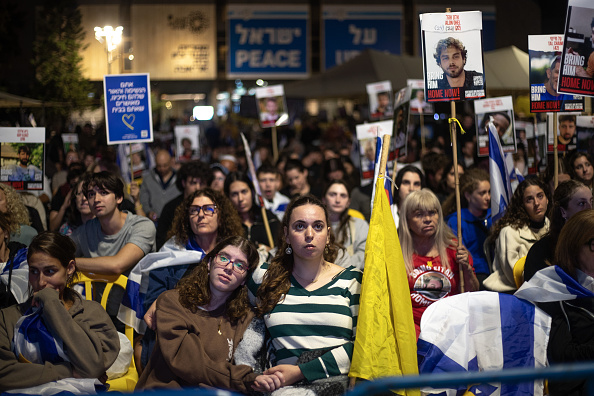Gaza City — Hamas on Monday handed over the first seven of the 20 surviving Israeli hostages to representatives of the International Committee of the Red Cross (ICRC) in Gaza, prompting scenes of jubilation in Tel Aviv, where crowds gathered in Hostage Square to support the families of captives.
The handover marked the first phase of a ceasefire and prisoner exchange agreement brokered by U.S. President Donald Trump, ending two years of brutal war between Israel and Hamas.

Under the deal, Hamas is expected to release all surviving Israeli hostages in exchange for the freedom of Palestinian prisoners held by Israel.
The Israeli military confirmed the initial release, saying,
“According to information provided by the Red Cross, seven hostages have been transferred into their custody and are en route to IDF and ISA forces in the Gaza Strip.”
The statement added that the Israeli Defense Forces were prepared to receive the remaining hostages expected to be handed over later in the day.
In Tel Aviv, crowds erupted in celebration as word spread of the first successful transfers.
“I’m torn between emotion and sadness for those who won’t be coming back,” said Noga, one of the relatives gathered at Hostage Square.
The hostage crisis began on October 7, 2023, when Hamas militants launched an unprecedented assault on Israel, killing 1,219 people, mostly civilians, and abducting 251 hostages.
While the majority were released during earlier truces, 47 remained captive — their families enduring years of anguish.
In Gaza, the ceasefire also brought a sense of fragile relief. Yet, much of the enclave remains in ruins after two years of conflict.
“I returned to Sheikh Radwan with my heart trembling,” said Fatima Salem, a 38-year-old Gazan resident.
“Nothing looked the same — even my neighbors’ houses were gone. Still, I missed the smell of my home, even if it’s now rubble. We’ll pitch a tent next to it and wait for reconstruction.”

President Donald Trump arrived in Israel on Monday aboard Air Force One, declaring the war “over” as he headed to a regional peace summit.
His whirlwind trip aims to celebrate his role in brokering the ceasefire and oversee the full implementation of the hostage exchange.
A billboard in Sharm el-Sheikh, Egypt, displayed portraits of Trump and Egyptian President Abdel Fattah al-Sisi, ahead of the Sharm el-Sheikh Peace Summit, underscoring the significance of the U.S.-led peace effort.
Speaking to reporters aboard Air Force One, Trump said:
“I think it’s going to hold. People are tired of it — it’s been centuries. The war is over. Okay? You understand that?”
He is expected to meet hostage families in Israel before addressing the Knesset in Jerusalem.
Trump’s visit also serves as a victory lap for the Gaza peace deal he helped negotiate — a 20-point peace plan unveiled in late September.
According to the plan, once Hamas hands over all surviving hostages, Israel will release about 2,000 Palestinian detainees, including 250 security prisoners and roughly 1,700 individuals detained during the war.
Israeli officials said they expected all 20 surviving hostages to be in Red Cross custody by early Monday morning.
Behind the scenes, negotiators were still resolving last-minute disputes. Two Hamas sources told AFP that the group had demanded the release of seven senior Palestinian leaders, some of whose names Israel had previously rejected.
Despite this, the sources confirmed that Hamas and its allies had “completed all preparations for the handover.”

Israel, however, does not expect all deceased hostages to be returned immediately. Under the agreement, Hamas will also return the remains of a soldier killed in 2014 during a previous Gaza war.
After concluding his visit to Israel, Trump is scheduled to travel to Egypt, where he and President al-Sisi will co-host a summit of over 20 world leaders in Sharm el-Sheikh to support his Middle East peace initiative.
Trump will seek to resolve lingering questions about the next phases of the plan — including Hamas’s refusal to disarm and Israel’s hesitancy to commit to a full withdrawal from Gaza.
He insisted, however, that he had “guarantees” from both parties and other regional actors about the deal’s implementation.
“Everybody’s very excited about this moment in time,” Trump said before departing Washington.
“We’ll establish a new governing body for Gaza very quickly — one that I will personally oversee.”
Under the roadmap, Israel will begin a partial withdrawal from Gaza, to be replaced by a multinational force coordinated through a U.S.-led command center in Israel.
According to the Gaza Health Ministry, at least 67,806 people have been killed in the territory since the start of the conflict — figures the United Nations considers credible.
While the data does not distinguish between combatants and civilians, it indicates that more than half of the victims were women and children.




